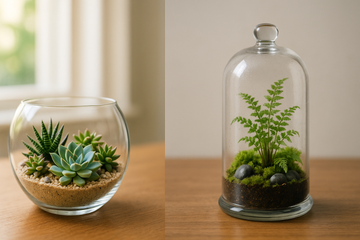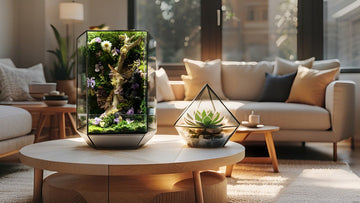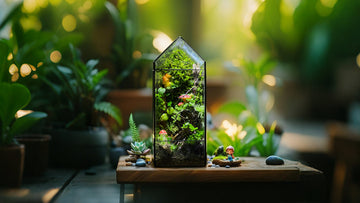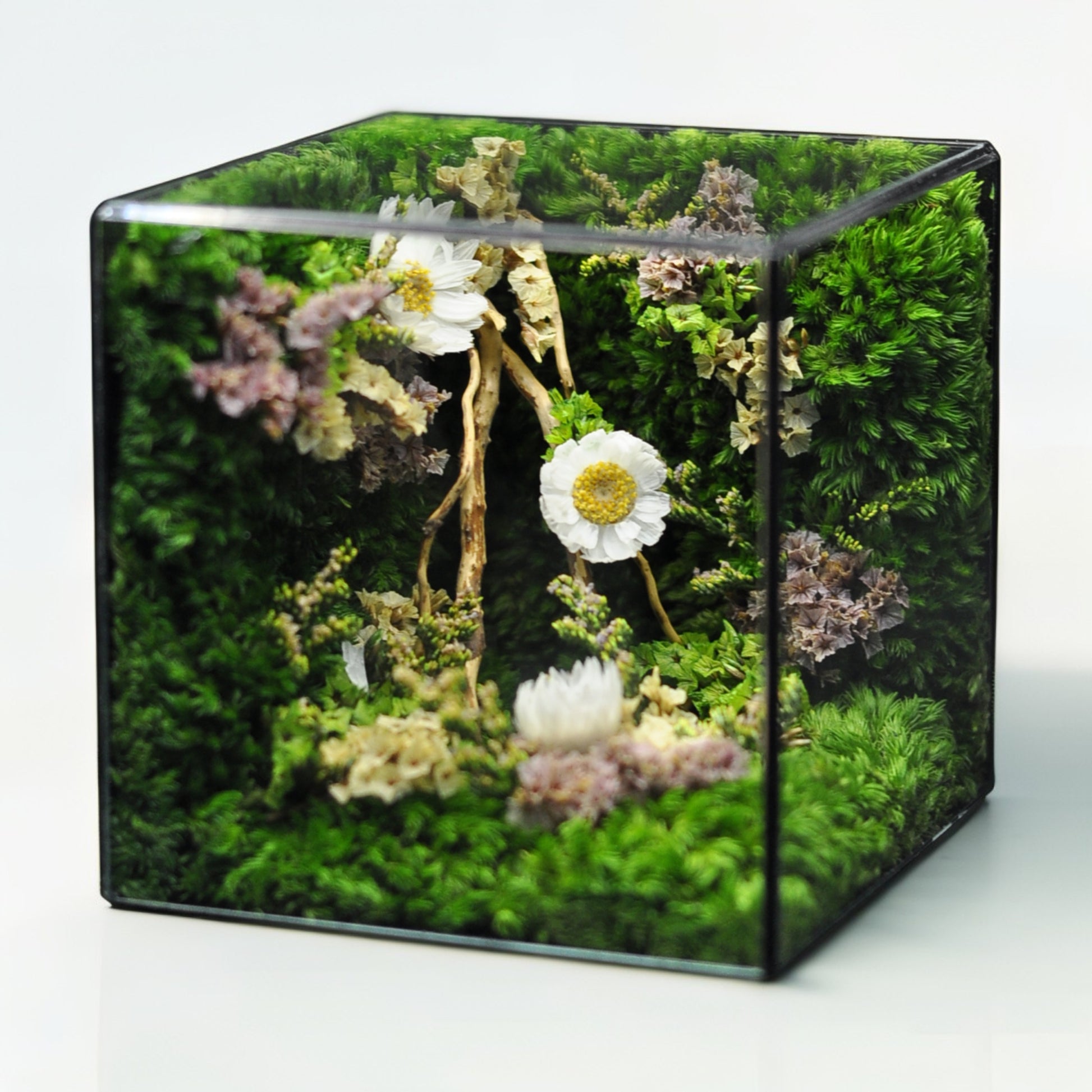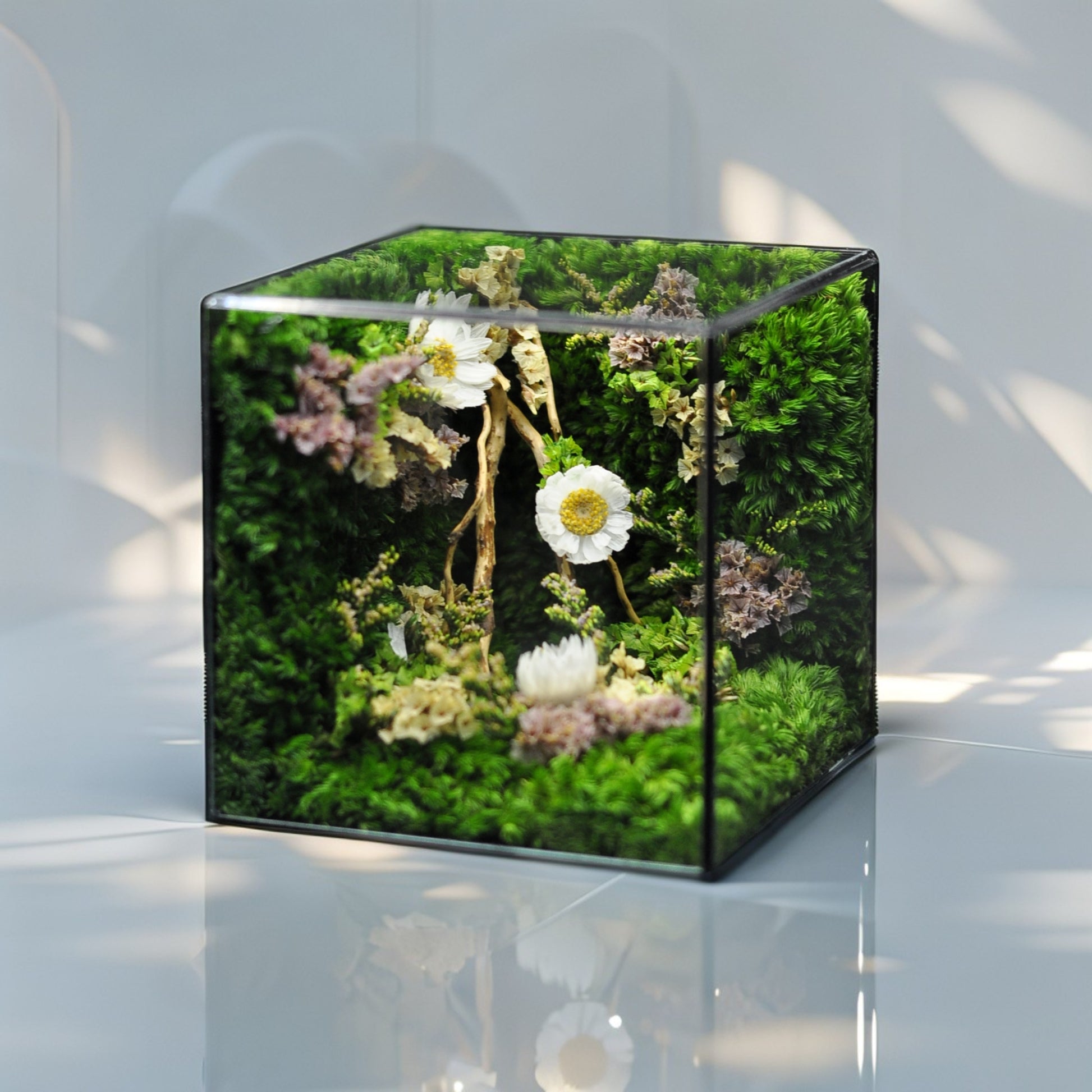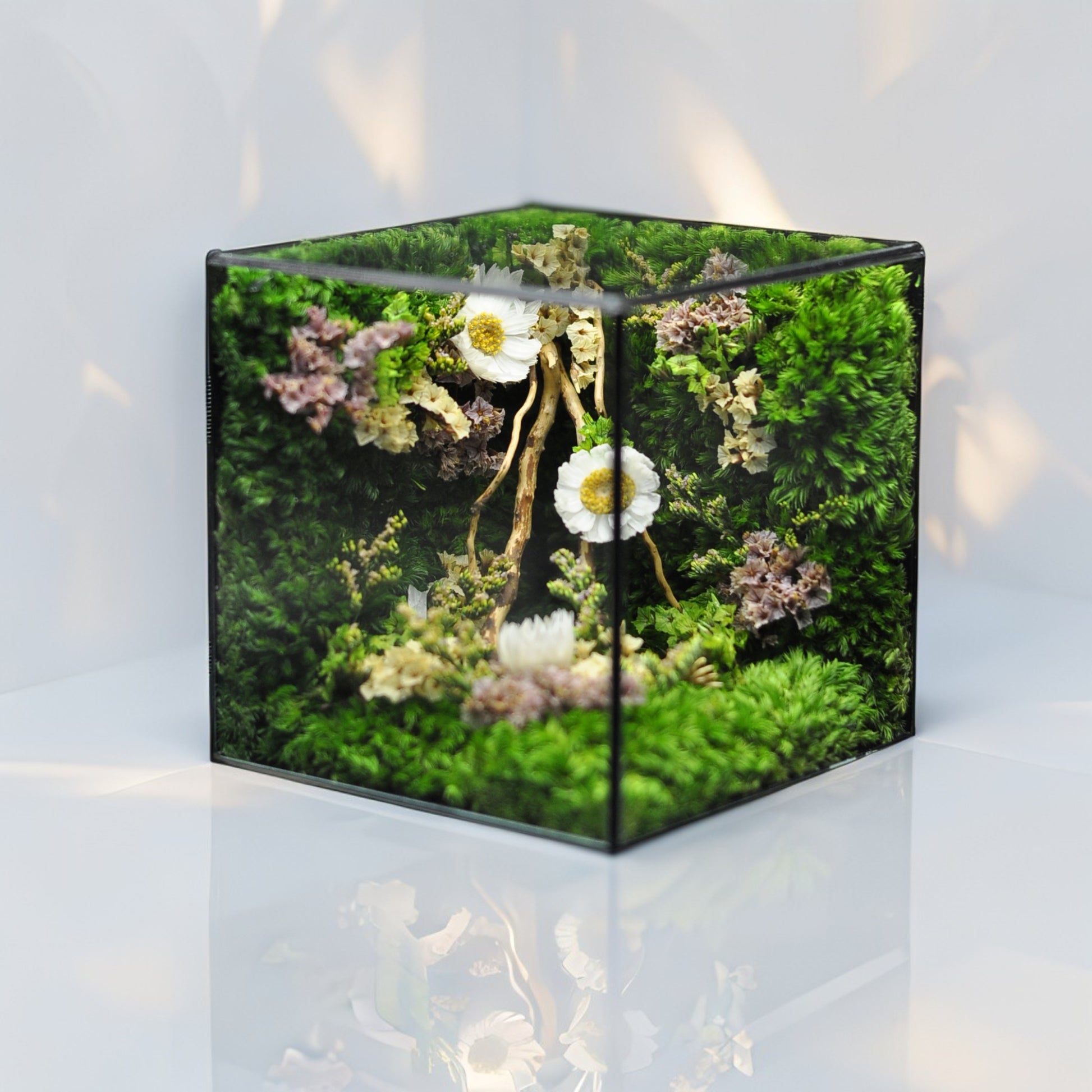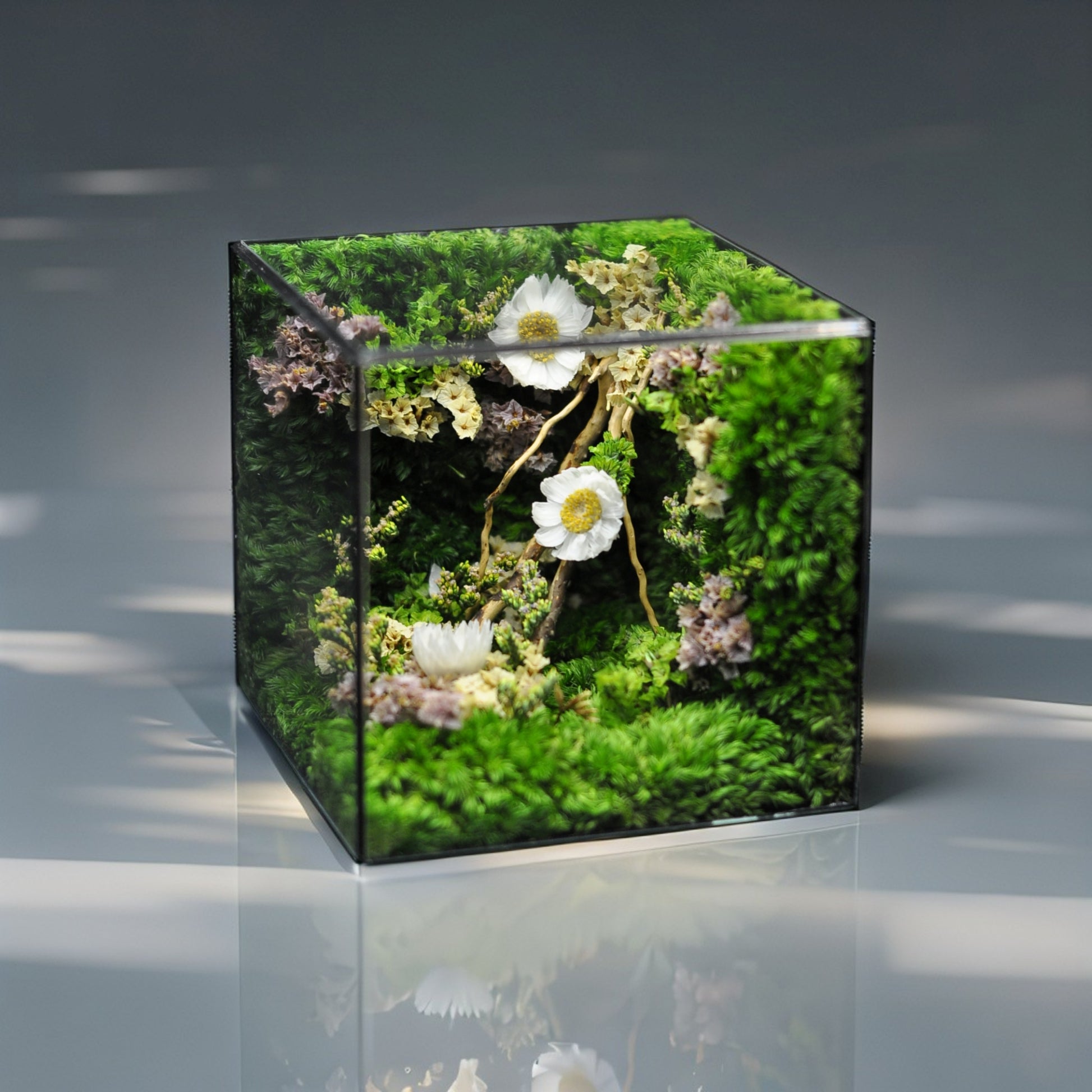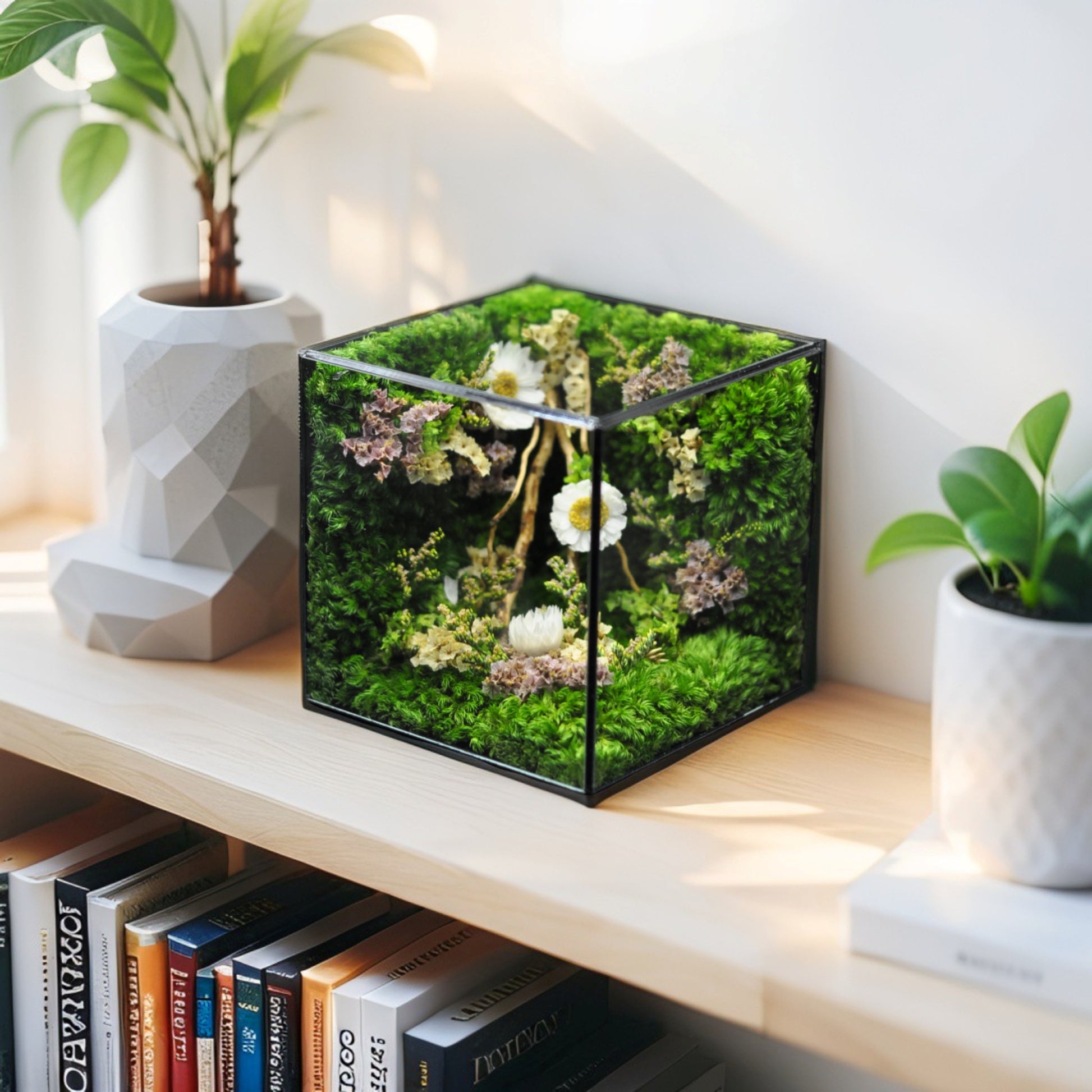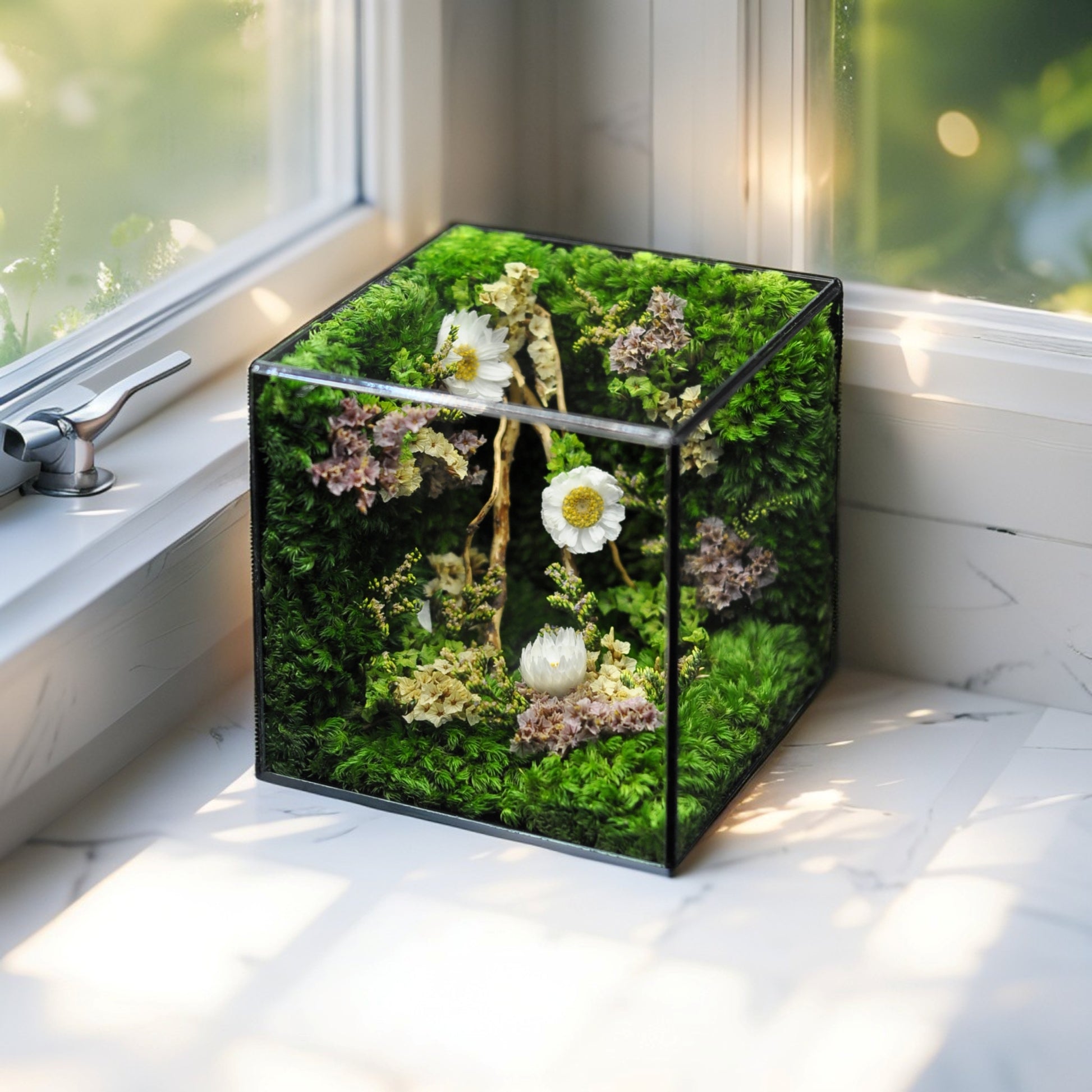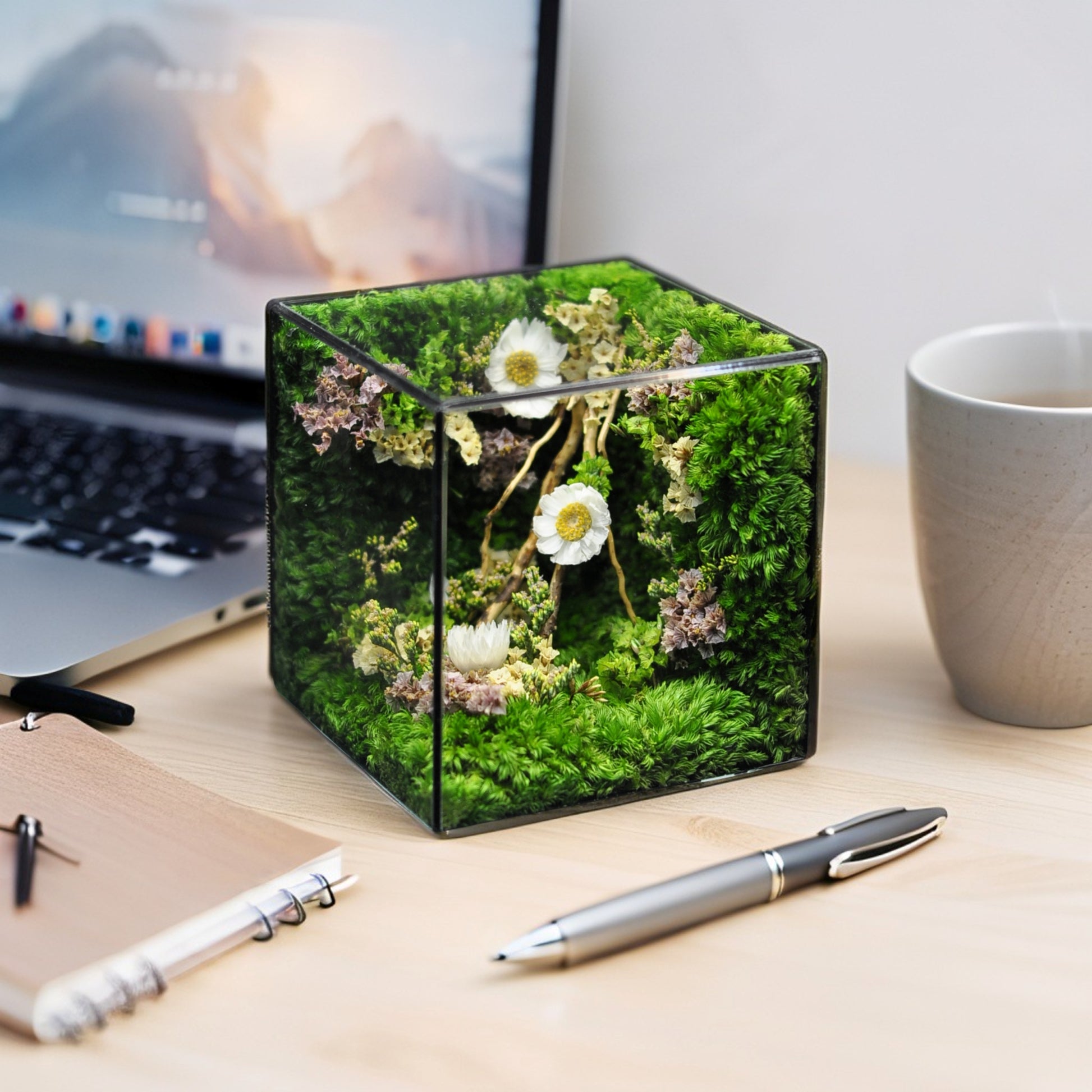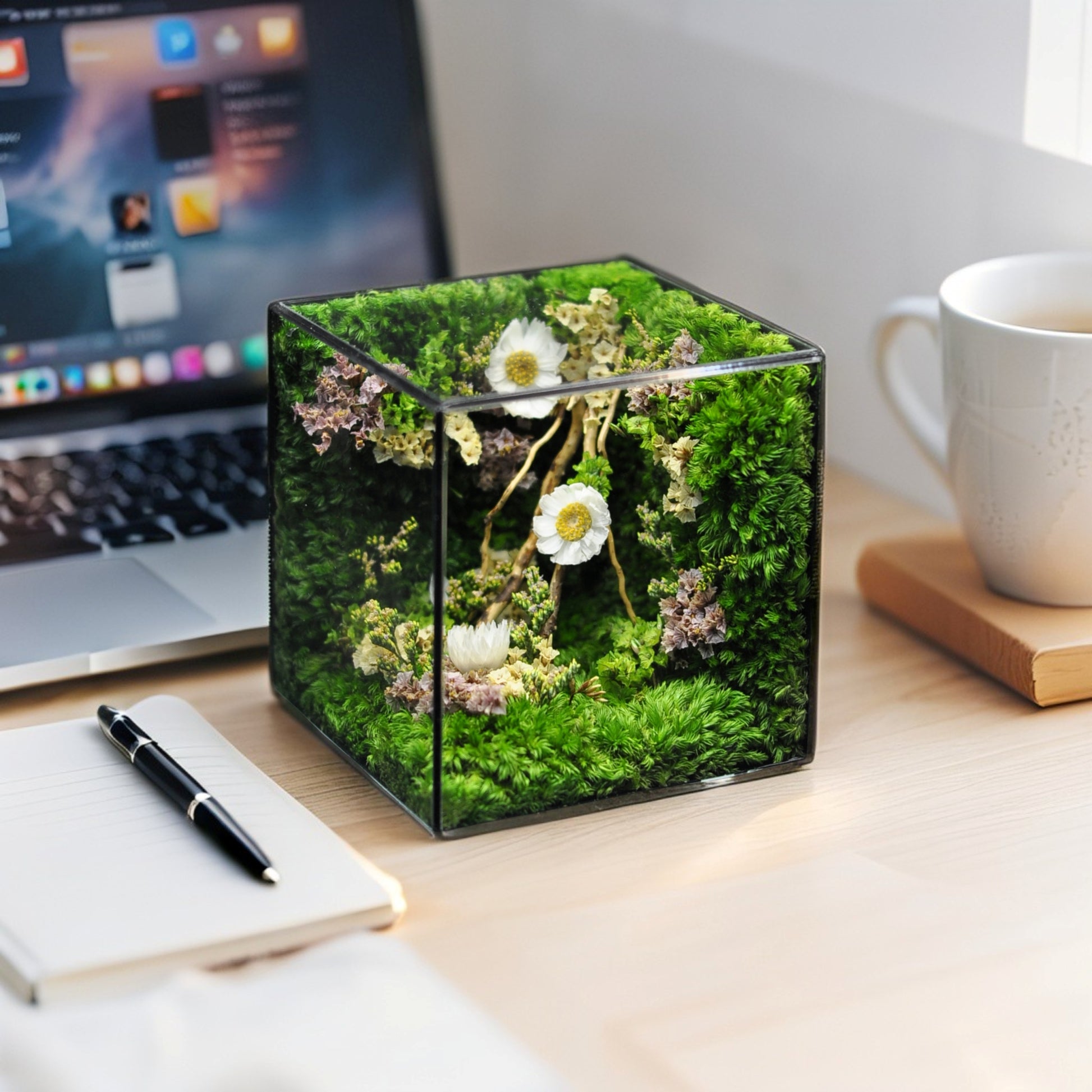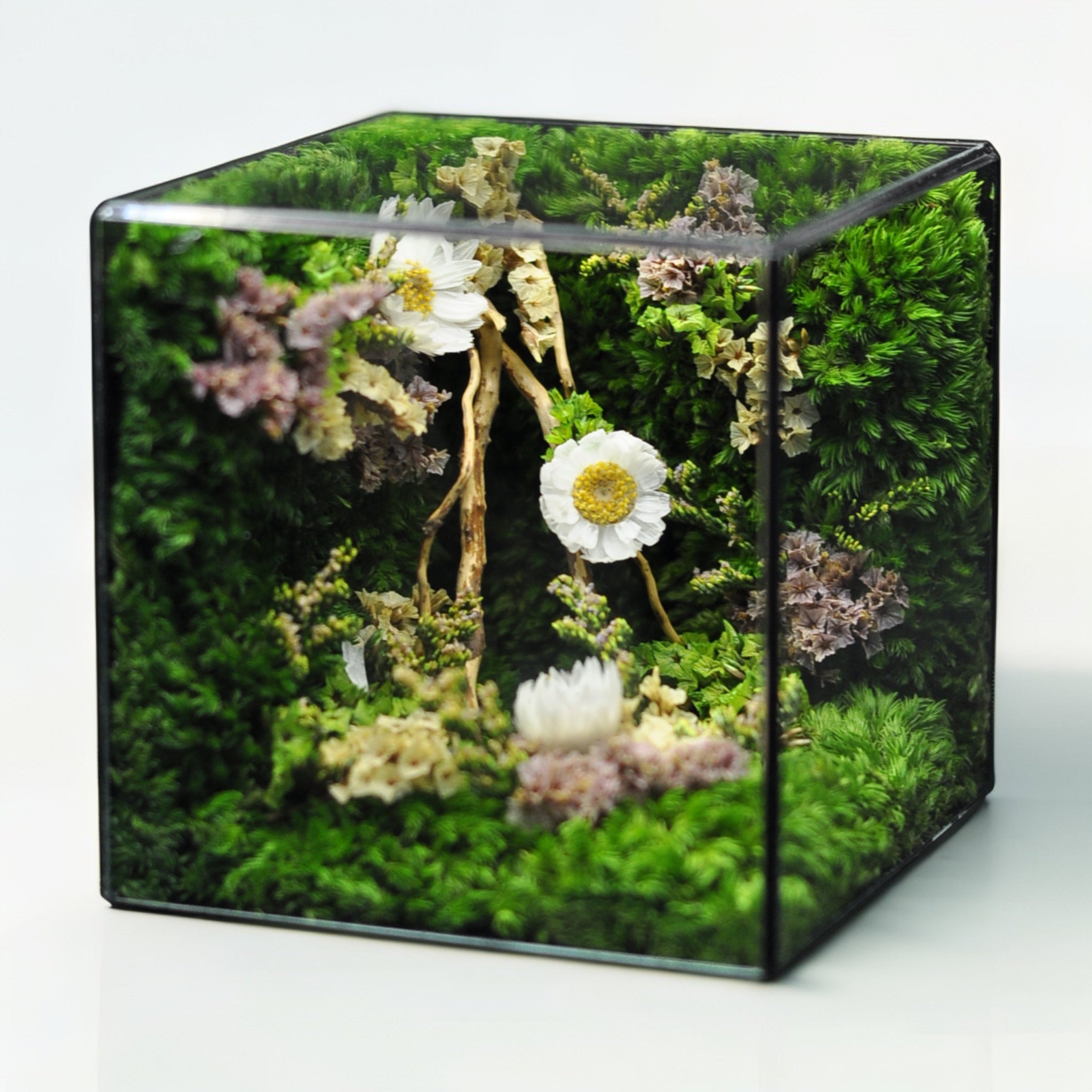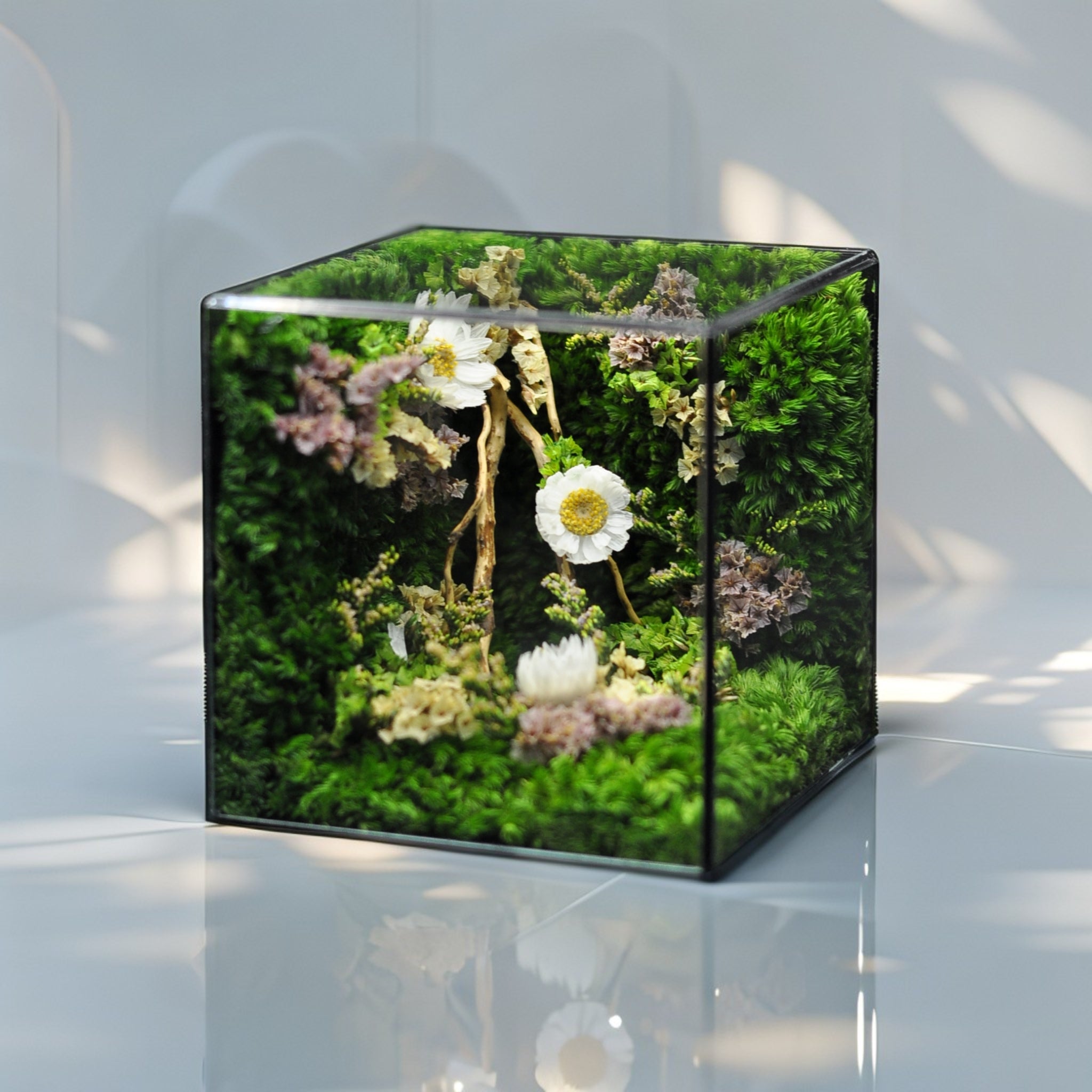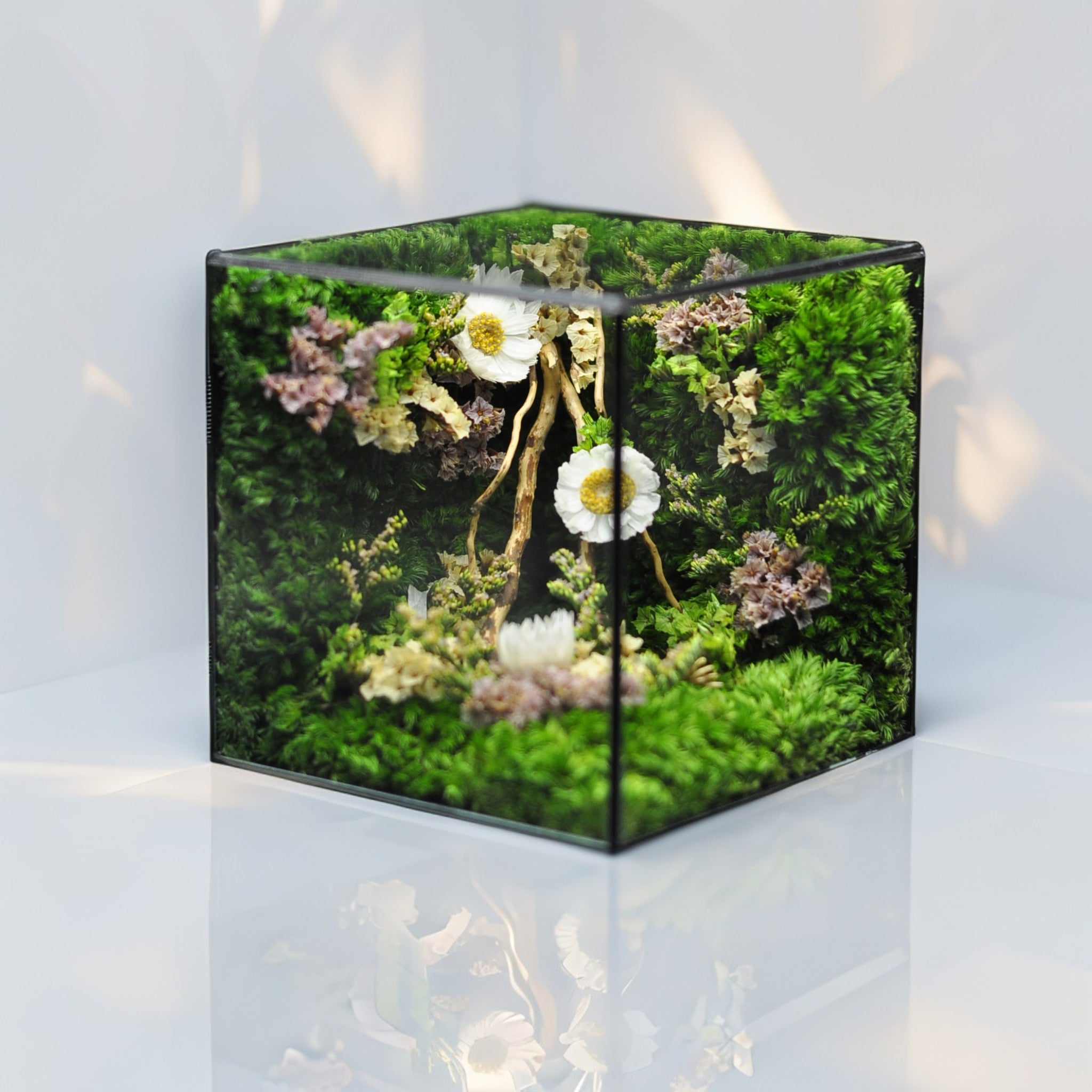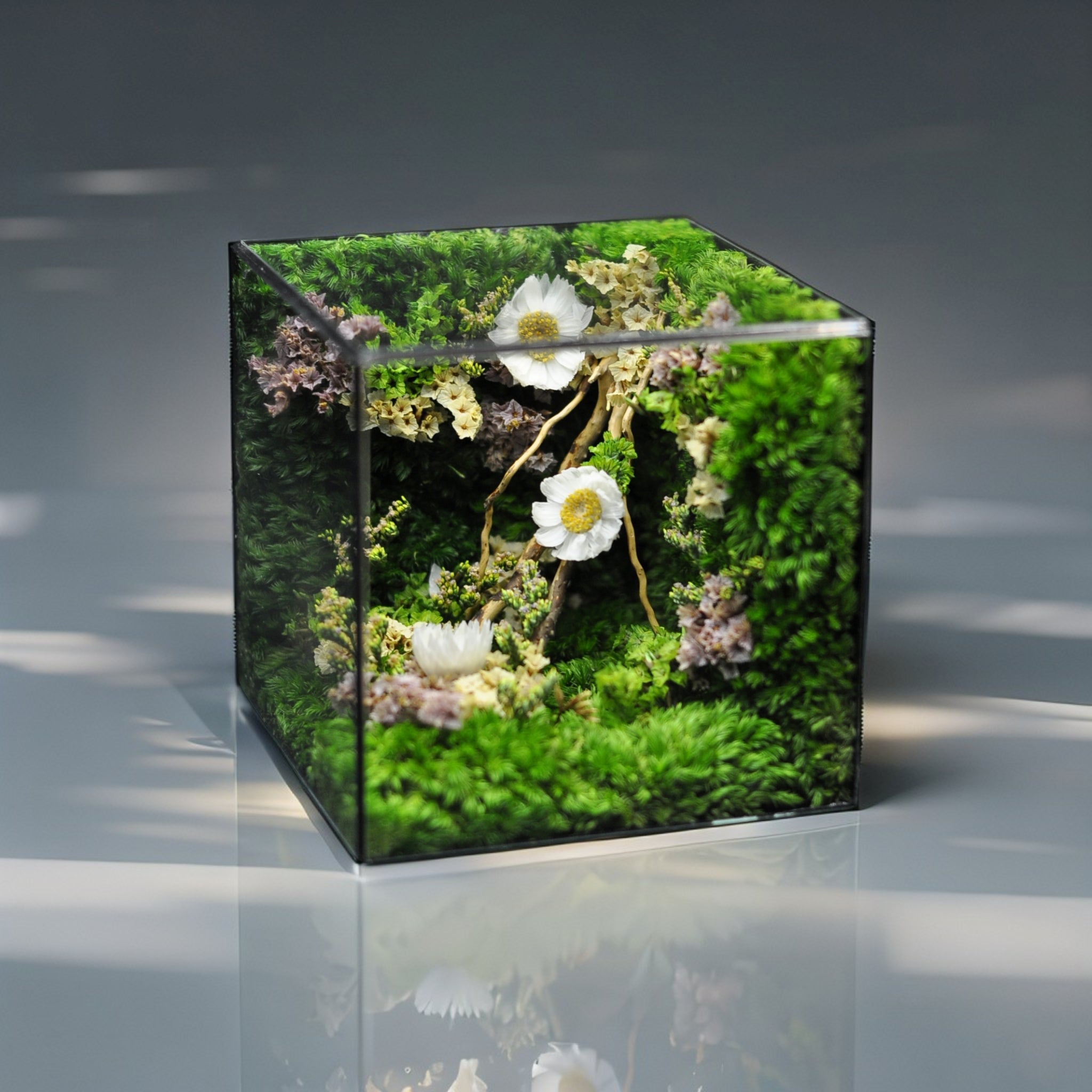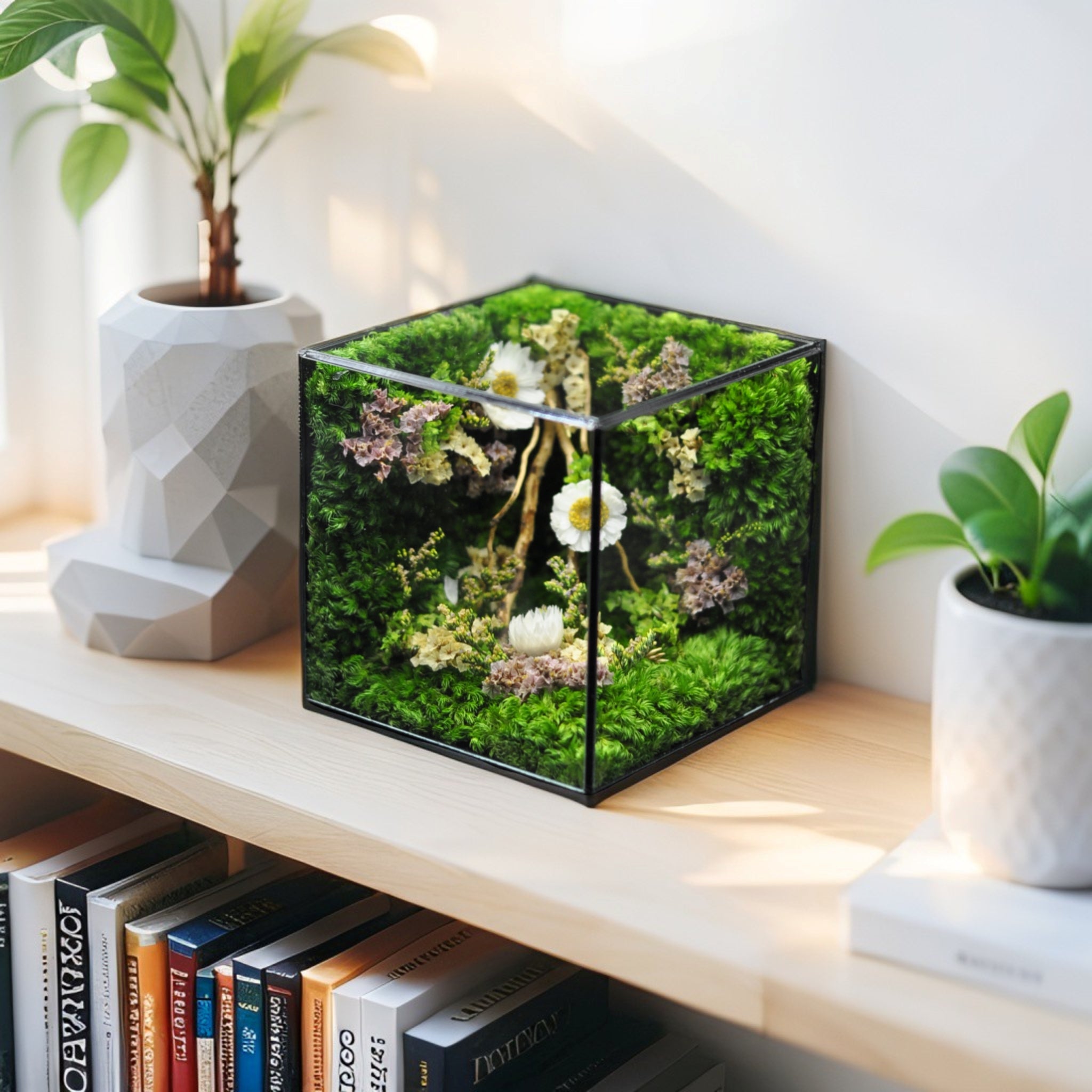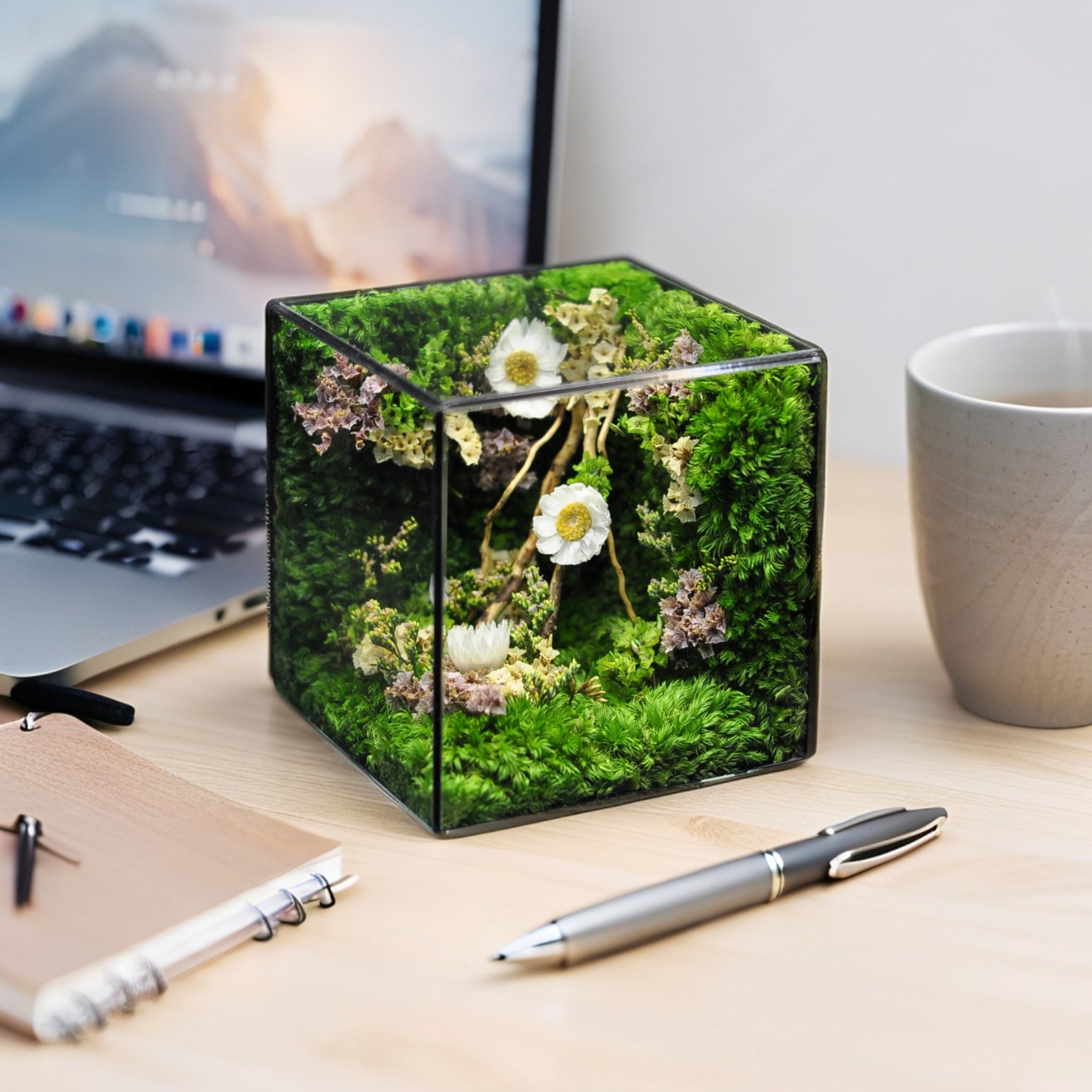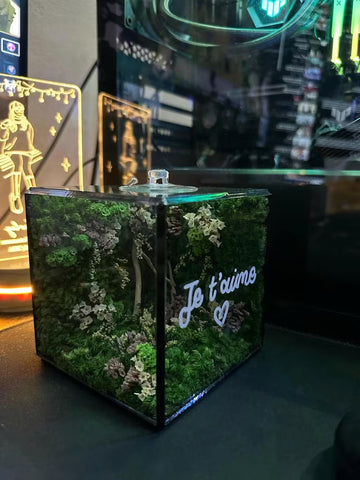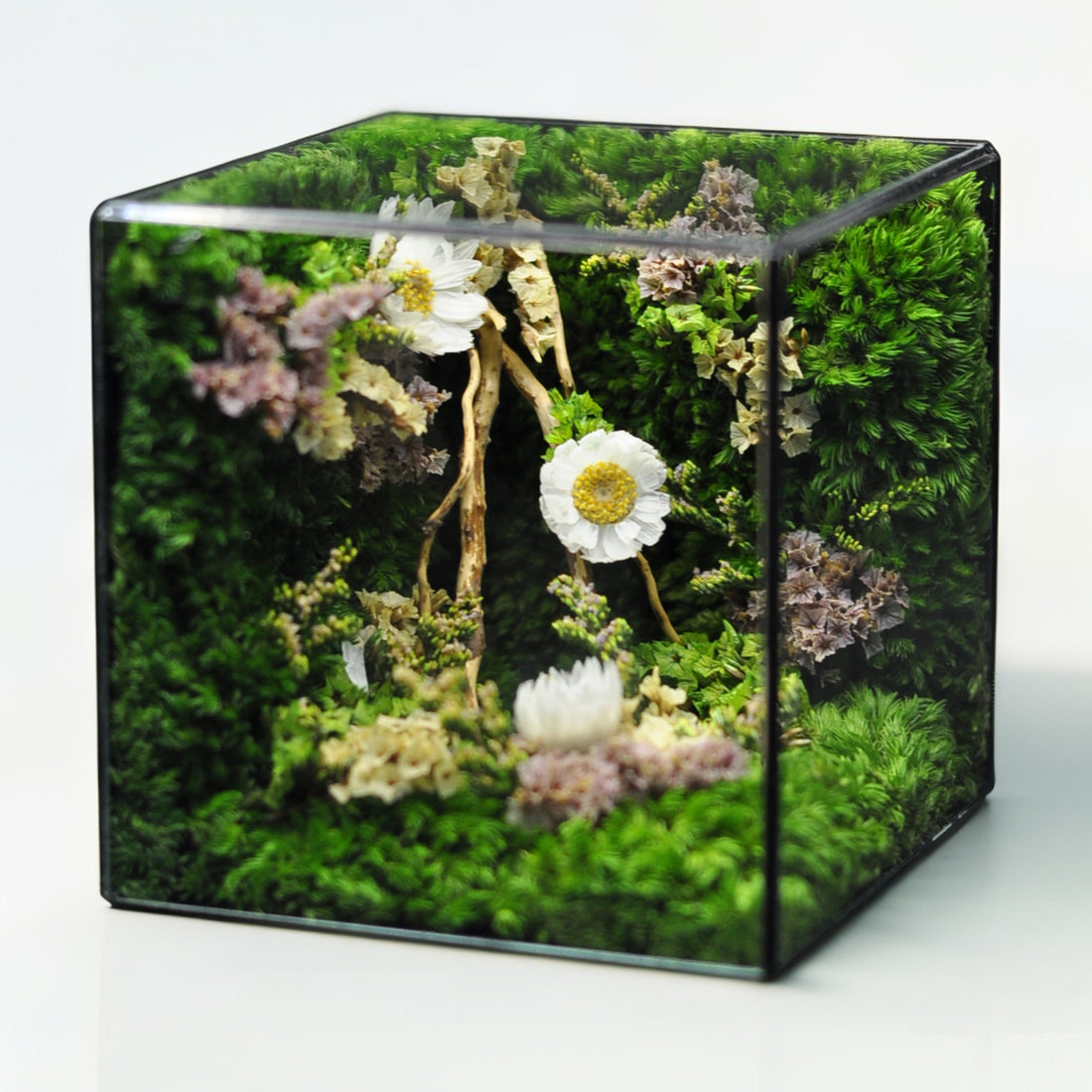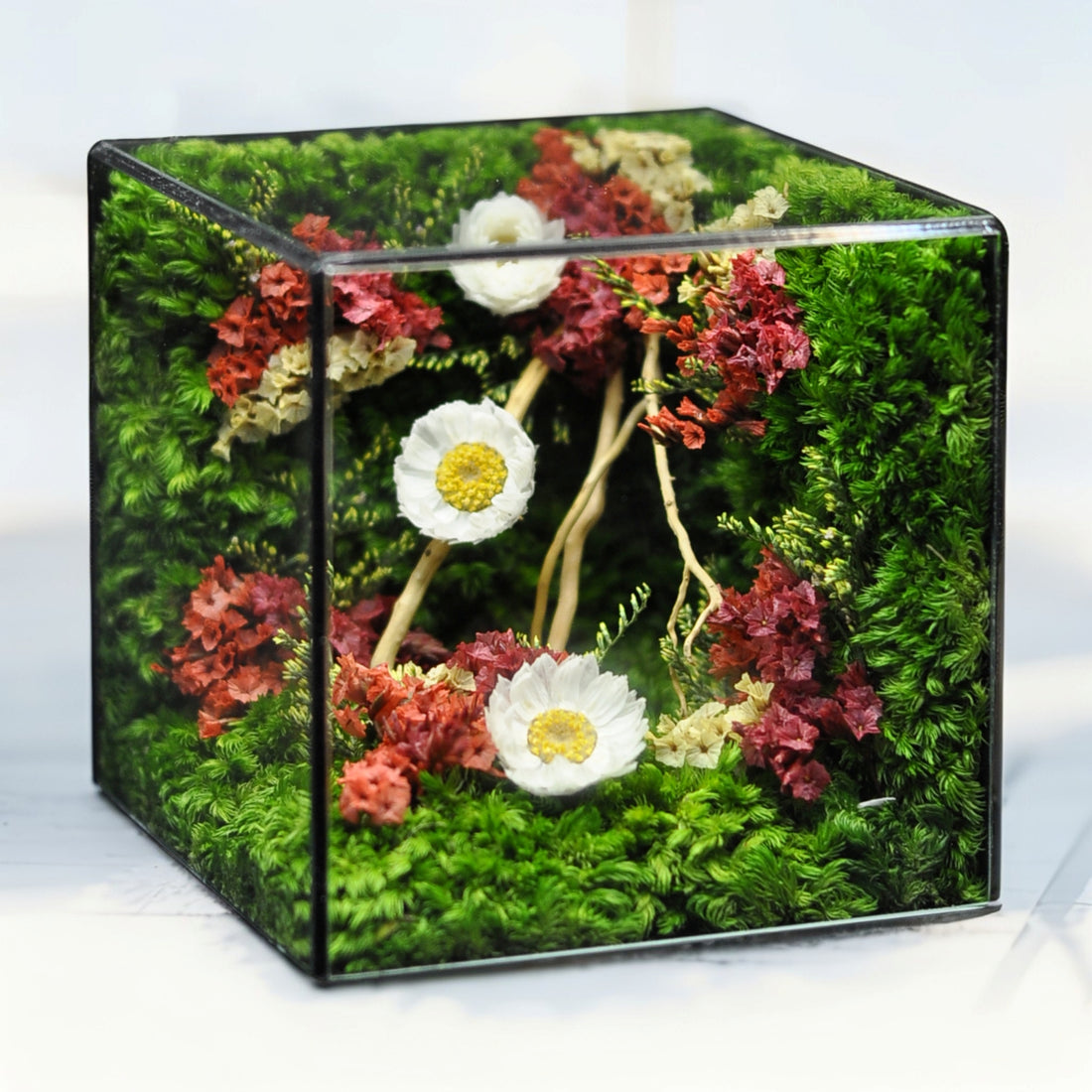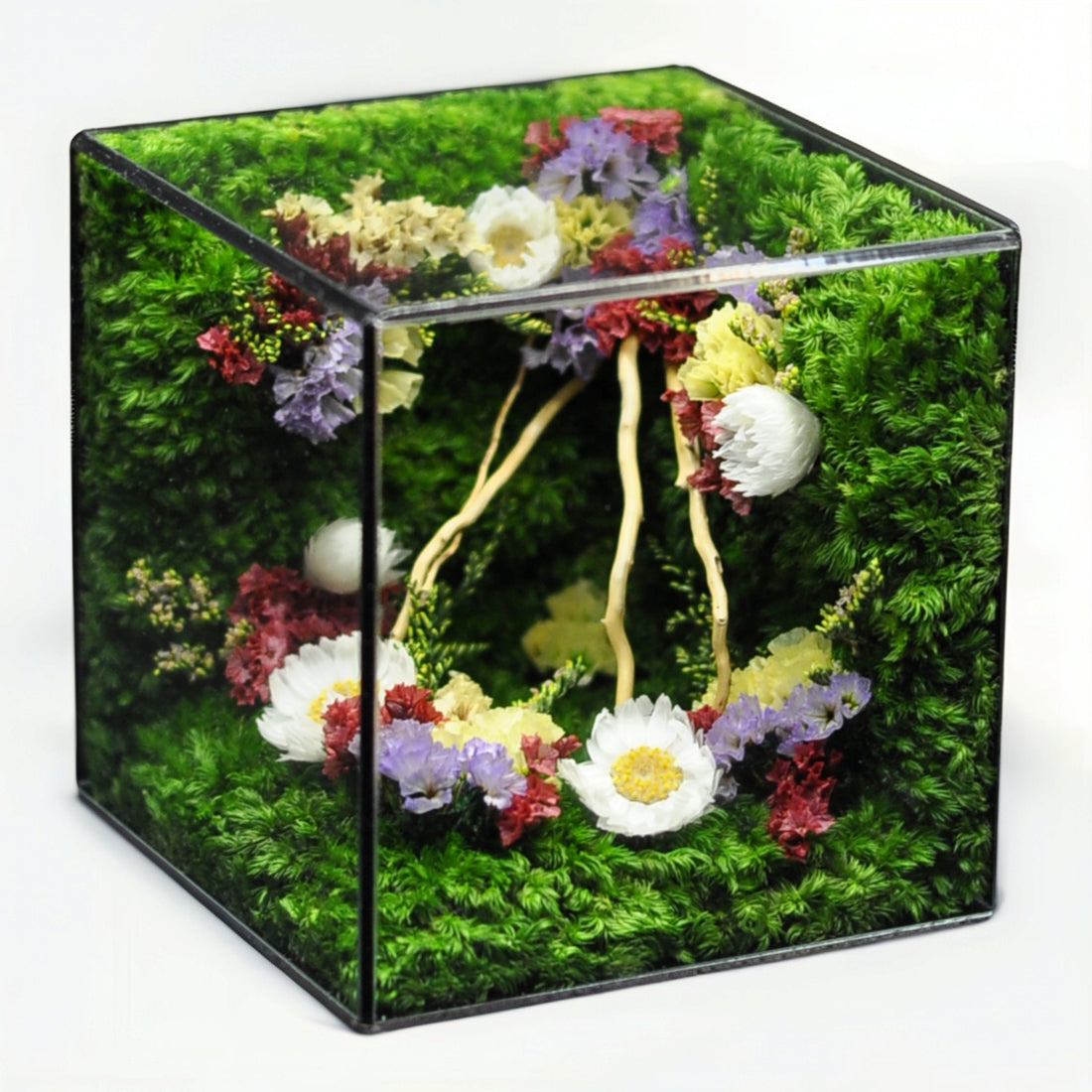Key Takeaways
Open and closed terrariums each offer unique design, plant, and upkeep profiles—yet most resources only touch on general “arium” comparisons. This guide delivers a focused, side-by-side look at open vs closed terrariums—covering moisture control, airflow, plant pairings, materials, costs, and skill levels—to help you cultivate your ideal mini-garden.
- Assess open vs closed terrarium designs: open models feature wide mouths for airflow and easy access, while sealed versions trap moisture for a self-regulating ecosystem.
- Match plant types to your terrarium: drought-tolerant succulents and cacti thrive in open setups, whereas ferns, mosses, and air plants flourish in the high-humidity environment of closed containers.
- Master humidity regulation vs air circulation: sealed terrariums maintain 70–90% humidity with minimal watering, while open designs rely on natural ventilation and require more frequent moisture.
- Optimize maintenance for your lifestyle: open terrariums demand weekly watering and occasional dusting, whereas closed setups need monthly inspections to manage condensation and prevent mold.
- Choose materials and costs wisely: repurposed glass jars and thrifted containers offer budget-friendly flair; premium glass kits and acrylic units deliver durability at a higher price point.
- Select the right style for your skill level: beginners benefit from open terrariums’ forgiving care and hardy plants, while experienced hobbyists can experiment with closed ecosystems and advanced humidity control.
- Embrace sustainable, low-maintenance houseplants: native mosses, resilient succulents, and air plants reduce watering needs and environmental impact in both terrarium types.
- Capitalize on our side-by-side design comparison: this in-depth analysis fills a gap by tailoring plant recommendations and upkeep advice—offering deeper insights than typical “terrarium vs. [other arium]” articles.
Armed with these insights, you’re ready to dive into the full breakdown of open vs closed terrarium styles—exploring DIY setups, plant pairings, and expert care tips to ensure your mini-garden thrives.
Introduction
Imagine nurturing a vibrant ecosystem right on your desk or windowsill—a mini-garden that not only beautifies your space but also fills it with life. The choice between an open and a closed terrarium can be the difference between a thriving indoor paradise and a struggling setup. Each style offers distinct characteristics that cater to different aesthetics, plant preferences, and levels of maintenance.
Understanding the nuances of open versus closed terrariums is essential for any plant enthusiast, whether you’re a novice or a seasoned green thumb. This guide takes a closer look at their unique designs, ideal plant pairings, maintenance needs, and cost considerations, empowering you to select the perfect terrarium for your lifestyle. Let’s dive into the details and discover which mini-garden style can turn your space into a natural sanctuary.
Terrarium vs Terrarium: Open vs Closed Overview
Crafting a mini-ecosystem can be as simple as choosing between an open, ventilated mini-garden or a sealed, self-sustaining eco-chamber. In this comprehensive side-by-side analysis, we dive into how design choices affect humidity, plant compatibility, maintenance routines, and aesthetic possibilities—helping you decide which terrarium style perfectly aligns with your space, lifestyle, and green-thumb aspirations.
What Is an Open Terrarium? (Open vs Closed Terrarium)
An open terrarium is an unsealed container—usually glass, acrylic, or ceramic—with a wide opening that encourages natural air movement. This ventilated design creates a drier microclimate ideal for sun-loving, drought-resistant plants. Key features include:
- Natural ventilation: continuous airflow prevents moisture build-up, mold, and mildew
- Easy access: hassle-free planting, pruning, and watering for hands-on care
- Clean display: transparent walls highlight layered soils, pebbles, and sculptural plant forms
Ideal applications: succulent collections, spiky xerophytes, air-plant vignettes, and any unsealed container setups that thrive on low humidity and bright light.
What Is a Closed Terrarium? (Sealed vs Open Terrarium)
A closed terrarium is a fully enclosed system—glass jars with tight lids, bell jars, or acrylic boxes—that traps moisture and establishes a miniature water cycle. This sealed design offers:
Pros:
- Self-watering ecosystem: condensation recycles moisture, reducing manual watering
- High humidity: ideal for plants that flourish at 70–80% RH (Royal Horticultural Society recommendation)
- Temperature buffer: stable internal climate protects sensitive species
Cons:
- Limited air exchange: stagnant air can breed mold, algae, and fungal gnats
- Narrow plant selection: drought-tolerant species often suffer in high humidity
- Occasional ventilation required to refresh the atmosphere
Pro Tip: introduce springtails or isopods (microfauna) to naturally suppress mold and decompose organic debris, reinforcing ecosystem balance.
Terrarium Design Comparison: Key Structural Differences (Terrarium Design Comparison)
Understanding how structure influences microclimates and care:
-
Moisture Control
-
Open: dries rapidly, requires weekly or biweekly watering
-
Closed: retains water, mist or pour lightly every 4–6 weeks
-
Air Circulation
-
Open: constant breeze reduces disease risk
-
Closed: periodic airing necessary to prevent stale conditions
-
Maintenance Access
-
Open: straightforward planting, trimming, and cleaning
-
Closed: careful lid removal to adjust moisture and manage growth
-
Styling Flexibility
-
Open: mix tall succulents, air plants, and decorative sand for a sculptural look
-
Closed: layer sheet moss, maidenhair fern, and charcoal in a lush, forest-floor tableau
With these design considerations, selecting the right plants becomes intuitive—let’s explore which greenery suits each style.
Plant Selection & Compatibility for Open vs Closed Terrariums
Thriving Plants for Open Terrariums: Succulents & Cacti (Which Terrarium Is Better for Beginners Open or Closed?)
Open terrariums are perfect for beginners thanks to their forgiving conditions. Recommended specimens and setup:
-
Plant Picks:
-
Echeveria ‘Lola’ and other rosette succulents
-
Haworthia attenuata for shade tolerance
-
Aloe vera for architectural form
-
Lithops (living stones) for novelty
-
Soil Mix:
-
1 part general-purpose potting mix (pH 6.5–7.5)
-
1 part coarse sand or horticultural perlite for drainage
-
Lighting:
-
6–8 hours of bright, direct sun or a full-spectrum LED grow light
-
Fertilizer:
-
Dilute cactus or succulent formula (1/4 strength) once per growing season
Beginners can quickly master an open terrarium’s simple care cycle and enjoy visible soil profiles and robust growth.
Thriving Plants for Closed Terrariums: Ferns, Mosses & Air Plants
Closed eco-chambers suit moisture-loving flora. Ideal choices and substrate details:
-
Ferns:
-
Boston fern (Nephrolepis exaltata) for arching fronds
-
Maidenhair fern (Adiantum spp.) for delicate texture
-
Mosses:
-
Sheet moss (Hypnum) in slightly acidic mix (pH 5.0–6.0)
-
Cushion moss (Leucobryum) for vibrant green carpets
-
Air Plants (Tillandsia spp.):
-
Select species like T. ionantha that tolerate periodic humidity spikes
-
Remove and dry specimens outside the terrarium after misting to prevent rot
Substrate Setup:
- Drainage layer: 1–2 inches of pebbles or coarse gravel
- Activated charcoal: 2–5 mm horticultural-grade for filtration
- Soil: peat-based or fern potting mix, moisture-retentive yet well-draining
Lighting: soft, indirect daylight; avoid direct sun that can overheat the sealed chamber.
Sustainable, Low-Maintenance Houseplants for Any Mini-Garden (Low-Maintenance Houseplants)
Eco-friendly picks that thrive in either terrarium style:
- Native Mosses: hardy, self-renewing, and carbon-sequestering
- Resilient Air Plants: substrate-free, no soil, occasional misting only
- Pothos Cuttings (Epipremnum aureum): trailing vines that adapt to humidity
- Baby Tears (Soleirolia soleirolii): carpet-forming ease in both open and closed vessels
- Carnivorous Cuttings: Venus flytrap (Dionaea muscipula) and sundew (Drosera) in a semi-sealed jar; maintain dormancy with cyclical lid-off periods and use only distilled water
By selecting sustainable species, you reduce waste and create a low-carbon indoor garden.
Maintenance Requirements: Humidity, Air Circulation & Watering
Maintaining the right environment is key. Once you’ve got watering and airflow dialed in, let’s talk containers and styling.
Mastering Humidity Regulation in a Closed Terrarium (How Do I Maintain Humidity in a Closed Terrarium?)
Closed terrariums flourish at 70–80% RH; higher levels can promote mold. According to the Royal Horticultural Society, this range supports most ferns and mosses while minimizing fungal risks.
-
Condensation Management
-
Wipe excess water with a microfiber cloth weekly
-
Open the lid for 5–10 minutes once a month to refresh air
-
Watering Frequency
-
Mist lightly every 4–6 weeks; avoid pooling water at the base
-
Monitoring Tools
-
Install a small hygrometer for accurate RH readings
-
Adjust light intensity: too much heat spikes moisture rapidly
Ensuring Proper Air Circulation in Open Terrariums (Air Circulation)
Airflow is your open terrarium’s secret weapon:
- Prevent Stagnation: place near a gentle fan or open window
- Clean Foliage: rinse leaves under a soft stream of water or dust monthly with a brush
- Container Choice: shallow bowls promote steady air exchange
Pro Tip: rotate the container 90° each week to encourage even plant development.
Watering Schedules & Common Mistakes (How Often Should I Water a Terrarium? Can Succulents Survive in a Sealed Terrarium?)
- Open Terrarium: water every 7–14 days when the top inch of soil feels dry
- Closed Terrarium: rely on the condensation cycle; mist or add 1–2 tablespoons of water every 4–6 weeks
Common Pitfalls:
- Overwatering: yellowing leaves, root rot, mold outbreaks
- Underwatering: drooping fronds, brown moss, slowed growth
Succulents generally do not adapt to the high-humidity environment of sealed terrariums because they require rapid drainage and arid air (cite).
DIY Materials, Cost Analysis & Design Tips
Budget-Friendly & Upcycled Container Options
- Mason jars, upcycled pickle jars, or wine bottles
- Thrift shop finds: glass vases, fish bowls
- Creative hack: terra-cotta lid with cling film seal
Premium Glass & Acrylic Kits: Pros & Cons
-
Glass Kits
-
Pros: crystal clarity, scratch-resistant finish
-
Cons: fragile, heavy, \$30–\$100+
-
Acrylic Kits
-
Pros: lightweight, shatterproof
-
Cons: prone to scratches, may yellow over time
Cost Breakdown & Design Tips for Every Budget
- \$10–\$20: thrifted jar + gravel + basic potting mix + starter cuttings
- \$30–\$50: beginner terrarium kit with tools and decorative accents
- \$100+: designer glass eco-chamber, premium plant selection, automated misting system
Design Tips:
- Showcase substrate layers with contrasting colors
- Combine textures—moss, pebbles, driftwood—for visual depth
- Select a cohesive palette: deep greens, earthy browns, and neutral accents
Choosing Your Ideal Terrarium: Skill Level & Lifestyle Match
Open vs Closed Terrarium for Beginners: Which Is Better? (Long-Tail Keyword)
Novices often excel with open terrariums because they provide:
- Forgiving care: easy to identify moisture needs
- Hardy pairings: succulents, aloe, air plants
- Quick satisfaction: rapid growth and minimal risk of mold
Advanced or Hobbyist Terrariums: Closed Ecosystem Techniques
Experienced growers can fine-tune sealed systems with:
- Automated Misting: programmable drippers for consistent humidity
- Humidity Control Tools: digital hygrometers, mini-humidistats
- Ecosystem Balance: test soil pH, prune for airflow, introduce microfauna
Aligning Maintenance Frequency with Your Lifestyle
- Weekly Checks (Open): watering, light adjustments, dusting
- Monthly Inspections (Closed): condensation control, humidity checks, trim mold spots
Time Commitments:
- Busy Professionals: choose a sealed eco-chamber for “set-and-forget” ease
- Dedicated Hobbyists: opt for open arrangements for creative layering and hands-on design
Expert Advice, Troubleshooting & Case Studies
Common Challenges & Solutions
- Mold Prevention: ensure a charcoal barrier; open lid briefly if condensation is excessive
- Pest Control: sticky traps for fungus gnats; neem oil mist for scale insects
- Temperature Management: move containers away from direct sun to avoid overheating
Expert Tips for Thriving Terrariums
- Light Optimization: aim for bright, indirect light; rotate vessels weekly
- Substrate Layering: gravel → charcoal → pH-balanced soil → decorative top
- Long-Term Care: prune dead foliage, refresh plant groupings every 12–24 months
Real-World Case Studies: Success Stories
- Beginner’s Open Terrarium Journey
- Setup: \$15 thrifted bowl, succulent trio, layered sand
- Metrics: weekly care yielded 20% larger rosettes in 3 months, no pest issues
- Challenge: initial overwatering led to stem rot; adjusted to biweekly schedule
- Advanced Closed Ecosystem Experiment
- Setup: sealed bell jar with maidenhair fern and springtail colony, automated mist every 5 days
- Metrics: maintained 72–78% RH for 18 months, lush understory, stable microfauna population
- Lesson Learned: needed monthly airing to prevent algae on glass
Frequently Asked Questions (FAQs)
What is the difference between an open and closed terrarium?
Open terrariums feature natural ventilation for drought-tolerant plants; closed terrariums are sealed environments that maintain high humidity for moisture-loving species (cite).
Can succulents survive in a sealed terrarium?
No. Succulents require low humidity and rapid drainage, conditions incompatible with sealed terrarium ecosystems.
How often should I water a terrarium?
- Open: every 7–14 days when the top inch of soil feels dry
- Closed: mist or add 1–2 tablespoons of water every 4–6 weeks
Conclusion
Choosing between an open and closed terrarium ultimately hinges on your plant preferences, maintenance capabilities, and aesthetic goals. Open terrariums encourage air circulation and are ideal for sun-loving succulents, providing an easy-care option that can flourish with minimal oversight. In contrast, closed terrariums create self-sustaining ecosystems that support humidity-loving plants like ferns and mosses, albeit with more stringent maintenance requirements to prevent mold and stagnant air.
By understanding the unique characteristics and care needs associated with each style, you can select a terrarium that is both visually appealing and suited to your lifestyle. As you embark on your terrarium journey, consider how your choice aligns with your gardening aspirations and environmental preferences. With the right knowledge and attention, you can cultivate a thriving mini-ecosystem that enhances not only your space but also your connection to nature.
Frequently Asked Questions (FAQ)
Q: What is the difference between an open and closed terrarium?
A: Open terrariums are unsealed containers with wide openings for continuous airflow, creating a dry microclimate suited to drought-resistant plants. Closed terrariums are fully sealed systems that trap moisture to form a self-watering, high-humidity ecosystem ideal for moisture-loving species.
Q: What plants thrive in open terrariums?
A: Sun-loving, drought-resistant species like Echeveria ‘Lola’ and other rosette succulents, Haworthia attenuata, Aloe vera, and Lithops do best in open terrariums, planted in a mix of potting soil and coarse sand or perlite under bright light.
Q: What plants suit closed terrariums?
A: Closed terrariums favor moisture-loving plants such as Boston and maidenhair ferns, sheet and cushion moss, and air plants like Tillandsia ionantha, grown over layers of pebbles, activated charcoal, and peat-based soil under soft, indirect light.
Q: How often should I water open vs closed terrariums?
A: Open terrariums need watering every 7–14 days when the top inch of soil dries out. Closed terrariums rely on their condensation cycle and require a light mist or 1–2 tablespoons of water every 4–6 weeks.
Q: How do I maintain humidity in a closed terrarium?
A: Keep humidity at 70–80% RH by misting lightly every 4–6 weeks, wiping excess condensation weekly, opening the lid for 5–10 minutes once a month, and using a small hygrometer to monitor levels.
Q: Can succulents survive in a sealed terrarium?
A: No. Succulents need low humidity and rapid drainage, which sealed terrarium environments cannot provide, leading to rot and poor growth.
Q: Which terrarium style is better for beginners?
A: Open terrariums are better for beginners because they offer easy moisture control, visible soil layers, low mold risk, and hardy plant pairings like succulents and air plants for simple, hands-on care (cite).
Q: What budget-friendly materials can I use to create a terrarium?
A: You can use upcycled containers like mason or pickle jars, thrifted glass vases or fish bowls, or a terra-cotta lid sealed with cling film, combined with gravel, basic potting mix, and starter cuttings for an under-$20 setup.

